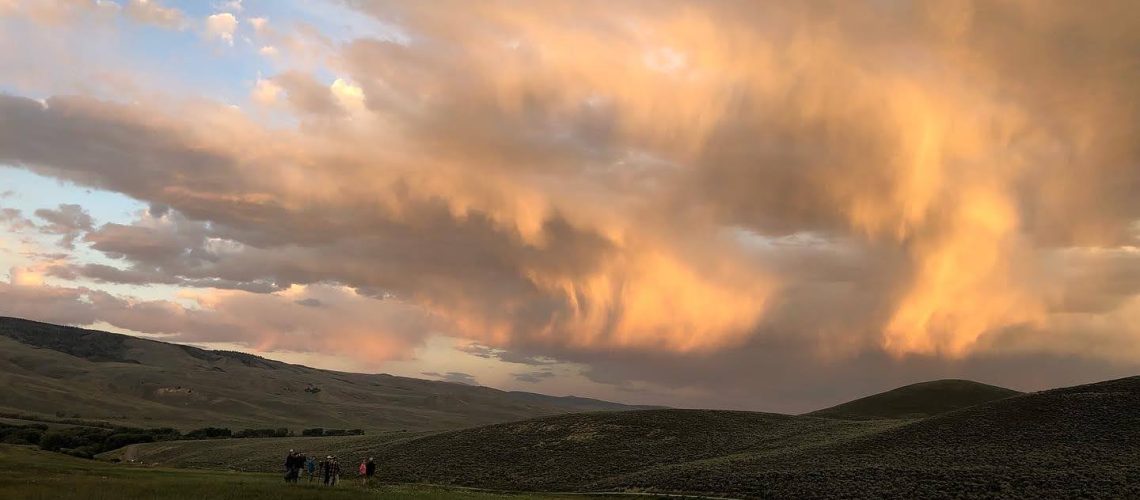Guest Post by Matt DeSaix, 2022-2023 Sustainability Leadership Fellow, and Ph.D. Candidate in the Department of Biology at Colorado State University
Wet meadow restoration
Blue sky stretches across the Gunnison Basin, and I lie down to take a break under the hot September sun. I manage to get at least some of my face shaded by positioning myself under the largest sagebrush I can find. For the past two days I have been working alongside a dozen-and-a-half other volunteers with Wildlands Restoration Volunteers (WRV) on a project spearheaded by the Gunnison Climate Working Group (SCWG) to restore wet meadows. While the defining feature in a sagebrush ecosystem is, not surprisingly, sagebrush, wet meadows play a crucial role in supporting ecosystem resilience and are a vital food source for sagebrush-dependent wildlife, such as the Gunnison sage-grouse (Centrocercus minimus). As of 2014, the Gunnison sage-grouse was listed as a federally threatened species in the United States and placed on the 2016 State of North America’s Birds’ Watch List. With an estimated population of 4,600 individuals limited to western Colorado and far-eastern Utah, the Gunnison sage-grouse is considered to be at risk of extinction without conservation action.
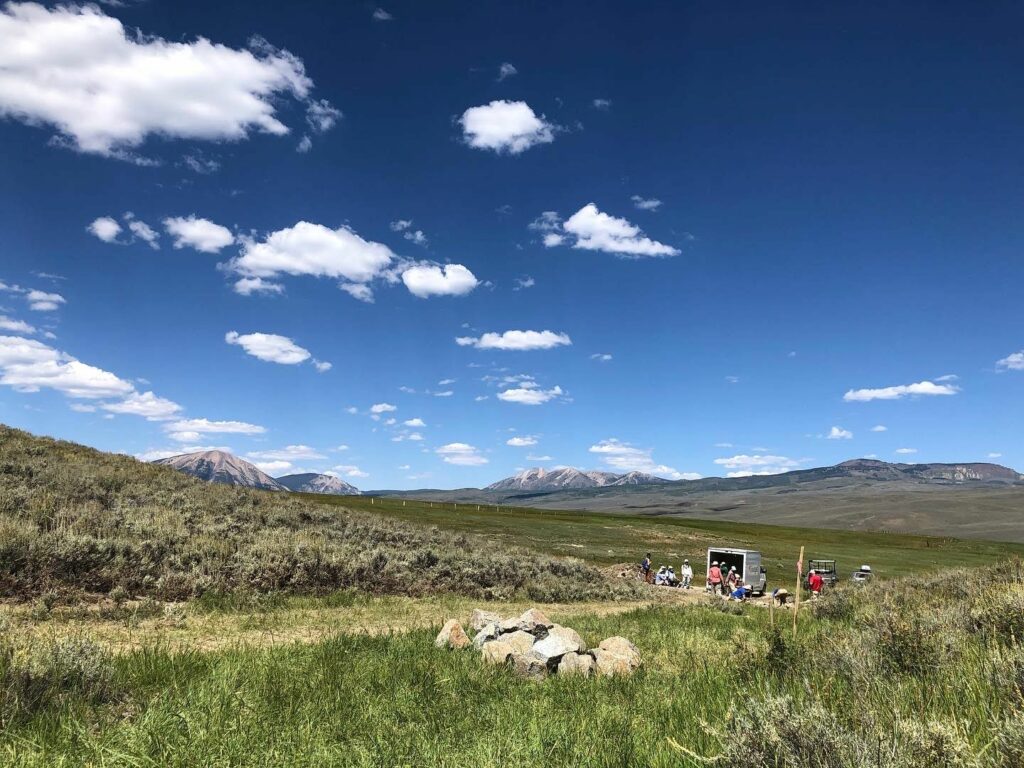
Wet meadows are a natural component of the sagebrush ecosystem but don’t actually contain sagebrush themselves. The soil in a healthy wet meadow contains more water moisture than the surrounding sagebrush can tolerate and therefore supports an array of hydrophilic (water-loving) plants. Wet meadows have been greatly reduced in their numbers due to erosion, drought, and historic, as well as contemporary, land-use practices. Herds of native and domesticate ungulates, such as elk and cattle, exacerbate the issue by creating hard packed trails which shifts the landscape hydrology from a slow, diffuse spread of water to fast-moving channels. Ultimately, channelization prevents water from sufficiently seeping into the ground to support the water-loving plants that constitute a wet meadow and this allows the surrounding sagebrush to encroach in. If you can slow the water, you can drown the sagebrush roots, kill off a patch of sagebrush and the wet meadow returns. I think about this as I finish my much-needed break and go back to moving a 60 lb. rock for just that purpose.
The art of building rock structures
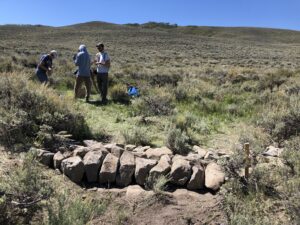
By lunchtime, my four-person group finishes our first rock structure of the day – a one rock dam. A one rock dam is not exactly as it sounds (i.e. a single rock), but is a single layer of rocks that extends across a channel. The downstream layer of rocks is of uniform height, between 6-16 inches, and gradually smaller rocks are placed upstream of this layer, creating a rough, rocky ramp. The purpose of a one rock dam is to slow water in a channel, collect sediment upstream of the structure, recruit vegetation, and gradually increase the height of the channel bed. Slow and gradual are the key words defining the approach of using rock structures for wet meadow restoration. Over the past couple of decades, Bill Zeedyk has become a leading pioneer in using simple rock structures for ecological restoration in semi-arid landscapes. His philosophy is to minimize the human disturbance involved in restoration and maximize the use of natural processes. For example, one option to deal with a five-foot deep channel that is six feet wide would be to build a five-foot tall dam. But Bill’s slogan is “Think like water”. What does water do when it hits an obstacle? It wants to go around. When the spring snow melt surges through the channel and hits the dam, the water will bounce off and quickly erode the channel on both sides of the dam. Now you have an eight-foot-wide channel to deal with. On the other hand, with a one rock dam that is only 12 inches tall, water will slow down through the rocks preceding the dam and then slowly pour over the top of the dam. Sediment collects between the rocks and over the coming year, vegetation starts to grow up through the sediment. Within a year or two the dam is completely submerged in soil and now the channel upstream of the dam is only four feet deep. Then you can come back, build another one rock dam, and the process repeats.
Conservation with computers
As a conservation genomicist who studies birds, one reason I enjoy my time on WRV volunteer projects building rock structures is that the majority of my typical work is spent in front of a computer. Occasionally, I have the opportunity to go into the field to collect DNA samples from birds, which involves luring birds to fly into a large volleyball-like net (i.e. mist net) from which I can safely remove them, take a single feather or drop of blood, and then let them go on their way. Contained in that single feather or drop of blood is the entire genetic code of an individual bird – the genome. All my time on the computer as a conservation genomicist is spent decoding the information in birds’ genomes that can help inform conservation and management efforts for a species.
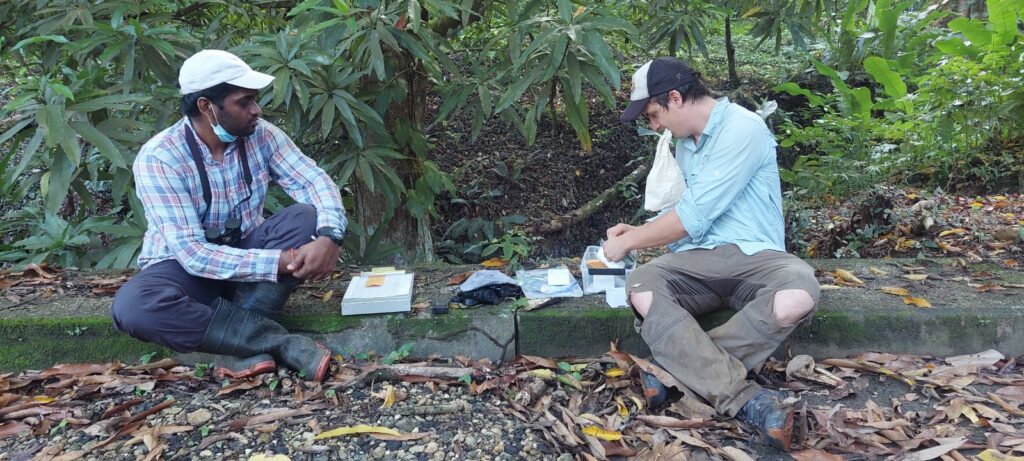
For example, by looking at approximately 26,000 letters of the genetic code from Prothonotary Warblers (Protonotaria citrea), my collaborators and I revealed that individuals at wintering sites in Colombia likely migrated there from across their breeding range in the eastern United States instead of being only from a subset of their breeding range. Tracking how breeding and wintering populations are connected in migratory species is part of the field of migratory connectivity. This information is critical for determining the causes of population decline, and whether declines are linked to factors (e.g., habitat loss) on the breeding grounds, wintering grounds, stopover sites during migration, or all of the above. More recently, my genomics research has focused on how birds are currently adapted to their environment and the potential for climate change to disrupt this adaptation. In collaboration with researchers at Colorado State University, University of California Santa Cruz, Denver Museum of Nature and Science, and Colorado Parks and Wildlife, we have demonstrated that in the next 30 years, the Brown-capped Rosy-Finch (Leucosticte australis), an alpine species of the southern Rocky Mountains, will experience novel climate conditions that it is not currently adapted to. However, the genomic data also reveals that the species has high genetic diversity, which may facilitate rapid adaptation to a changing climate and mitigate adverse effects of climate change. Those letters of genetic code, that us genomicists stare at and spend hours manipulating on the computer screen, are helping us figure out how to best protect these species.
A poop of hope
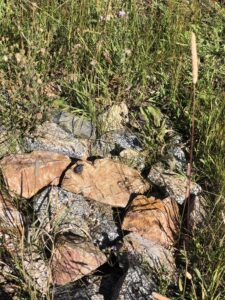
While we finish my team’s last rock structure of the day, I think of the contrasting elements of the wet meadow restoration project and my own research aimed at conservation. Apart from the stark difference in the physical nature of the two (hands on rocks vs. hands on computers), I realize how much I enjoy getting to see a tangible product as the result of conservation work. The genomics research I do provides valuable information that helps species conservation and management, but I don’t get to see the outcome. At the end of a day building rock structures, I get to look at something. I get to see the product of spending hours with my team on our hands and knees, shuffling rocks around and trying to find the perfect fit between uneven rocks that don’t actually have a perfect fit. An exhausting, but rewarding game of Tetris where none of the pieces have right angles. I realize, too, that while the rock structure is a satisfying product of a day’s effort, it is not a tangible conservation outcome by itself. It is an object that we hope will help the sage-grouse and the sagebrush ecosystem. Like genomics research, it is a thread in a tapestry of conservation efforts being woven by countless individuals who want to protect biodiversity on this planet. Conservation work comes in all manners – from straining your body with a rock to straining your eyes with a screen – and all of it is needed.
My group walks to the top of the meadow to visit a rock structure we completed the previous day. To the untrained eye the one rock dam may look like an only slightly organized pile, but to us it is a work of art. We take a group picture and step back to admire the lack of gaps in the foundation and the relative evenness of the top. Suddenly, a member of the group points to some gunk on one of the rocks and excitedly says “Look!”. We all crowd around to investigate. There, on top of our rock structure, is a little pile of pellets and the tar-like excretion of a Gunnison sage-grouse. Of the 4,600 individuals left in the world, one of them decided to perch on our rock structure – leaving a symbolic, yet tangible, note of hope for the conservation of this species. Naturally, I think of all the genomic DNA contained in that little pile of bird poop, just waiting to be decoded.
